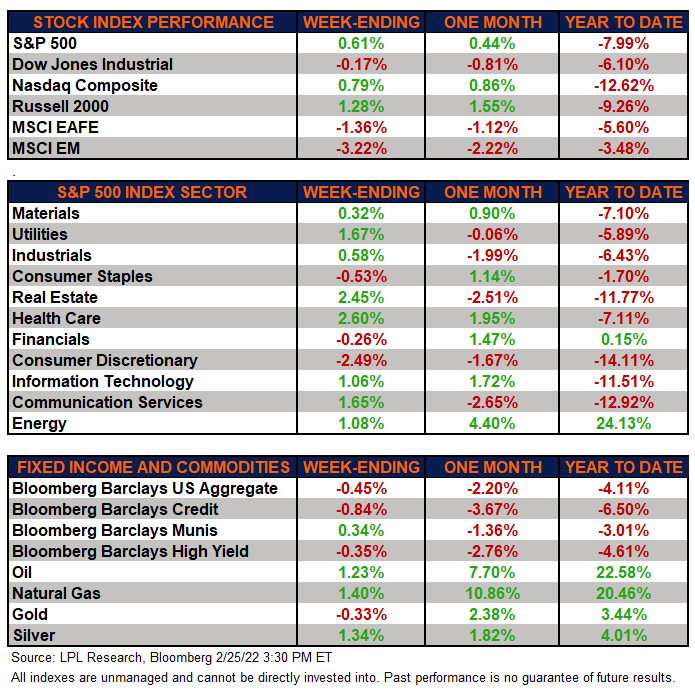
U.S. Markets Overcome Ukraine Challenges

U.S. and International Equities
Most Markets Lower
Firstly, our thoughts go out to those impacted by Russia’s invasion of Ukraine and we hope the conflict end’s quickly. This week, U.S. major equity markets finished higher with the exception of the Dow Jones Industrial Average. Clearly the Russia-Ukraine conflict has added to the previously existing monetary policy uncertainty and has given market participants pause this week. However, market rallied as investors took advantage of lower stock prices Friday afternoon based on developing signs that diplomacy may prevail. International markets finished lower this week, with emerging markets (MSCI EM) lower as economic and financial sanctions against Russia hindered the emerging markets index this week.
Fixed Income Continues Lower
The Bloomberg Aggregate Bond Index finished lower for the fifth straight week. High-quality bonds continue to be challenged in anticipation of Fed rate hikes, which will likely begin in March. This sentiment also carried over to high-yield corporate bonds, as tracked by the Bloomberg High Yield index, which lost ground for the week. That being said, high yield spreads, or the additional compensation for owning riskier debt, still remain well behaved due to continued favorable credit conditions.
Commodities Slightly Higher
Following last week’s rally, natural gas gained over 1% this week. Additionally, crude oil reversed course this week, finishing the week fractionally higher in wake of Russia’s attack on Ukraine. The major metals, gold, copper, and silver finished mixed this week.
Economic Weekly Roundup
Leading Economic Indicators Decline, But Still Positive
The Conference Board’s Leading Economic Index (LEI) fell in January, but still came in above levels reached during November of last year. Overall, the report is positive, considering the Omicron variant spikes in January. The headline leading economic indicators in January still point to economic growth this quarter. In addition, we expect to see a slight rebound during the second half of 2022.
Consumers Appear Less Confident
Per the Conference Board’s report Tuesday, consumers’ confidence in the U.S. economy waned this month. Moreover, the report has now shown a decline in confidence for the second consecutive month. Inflation concerns appear to have affected consumer’s mindset as prices keep rising, especially energy prices. Fuel is a primary expenditure for many and rising costs appear to be negatively affecting the consumer’s wallet.
Jobless Claims Decline
Initial claims for unemployment insurance increased for the week ending February 19 came in below last weeks’ total as well as economist expectations. Moreover, continuing claims declined from the prior week as well as below economist estimates. Consumer sentiment remains optimistic towards the labor markets according to the Conference Board as the drop in continuing claims may be signaling a long-awaited rebound in labor participation.
Week Ahead
The following economic data is slated to be released during the week ahead:
- Monday: January wholesale inventories
- Tuesday: February Markit Purchasing Managers’ Index, Institute for Supply Management Manufacturing Report, January construction spending
- Wednesday: Federal Reserve Beige Book, February ADP Employment Survey
- Thursday: Weekly initial and continuing unemployment claims, Bureau of Economic Analysis February vehicle sales, February Purchasing Managers’ Index, Institute for Supply Management Non-Manufacturing Report, January durable and factory orders, Q4 productivity and labor costs,
- Friday: February hourly earnings and workweek statistics, manufacturing and non-farm payrolls, February unemployment report
IMPORTANT DISCLOSURES
This material is for general information only and is not intended to provide specific advice or recommendations for any individual. There is no assurance that the views or strategies discussed are suitable for all investors or will yield positive outcomes. Investing involves risks including possible loss of principal. Any economic forecasts set forth may not develop as predicted and are subject to change.
References to markets, asset classes, and sectors are generally regarding the corresponding market index. Indexes are unmanaged statistical composites and cannot be invested into directly. Index performance is not indicative of the performance of any investment and do not reflect fees, expenses, or sales charges. All performance referenced is historical and is no guarantee of future results. All market and index data comes from FactSet and MarketWatch.
Any company names noted herein are for educational purposes only and not an indication of trading intent or a solicitation of their products or services. LPL Financial doesn’t provide research on individual equities. All information is believed to be from reliable sources; however, LPL Financial makes no representation as to its completeness or accuracy.
U.S. Treasuries may be considered “safe haven” investments but do carry some degree of risk including interest rate, credit, and market risk. Bonds are subject to market and interest rate risk if sold prior to maturity. Bond values will decline as interest rates rise and bonds are subject to availability and change in price.
For a list of descriptions of the indexes referenced in this publication, please visit our website at lplresearch.com/definitions.
This Research material was prepared by LPL Financial LLC.
Securities and advisory services offered through LPL Financial (LPL), a registered investment advisor and broker-dealer (member FINRA/SIPC).
Insurance products are offered through LPL or its licensed affiliates. To the extent you are receiving investment advice from a separately registered independent investment advisor that is not an LPL affiliate, please note LPL makes no representation with respect to such entity.
- Not Insured by FDIC/NCUA or Any Other Government Agency
- Not Bank/Credit Union Guaranteed
- Not Bank/Credit Union Deposits or Obligations
- May Lose Value
For Public Use – Tracking #1-05249335